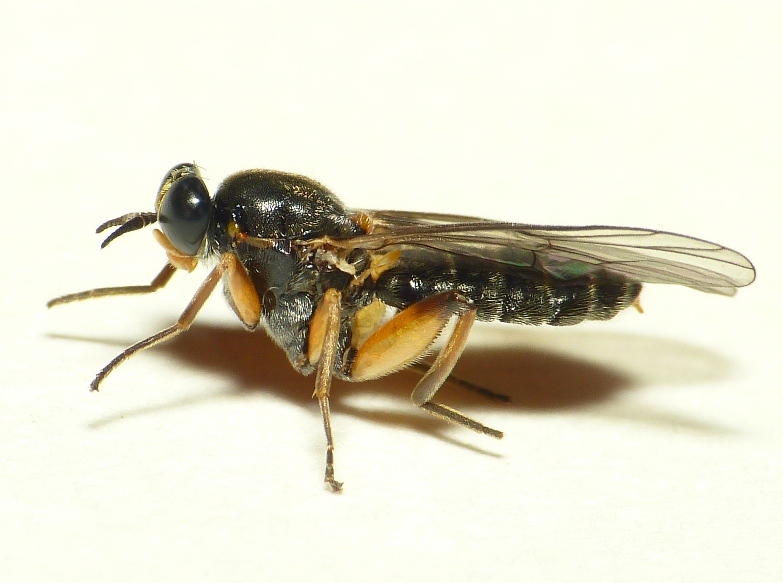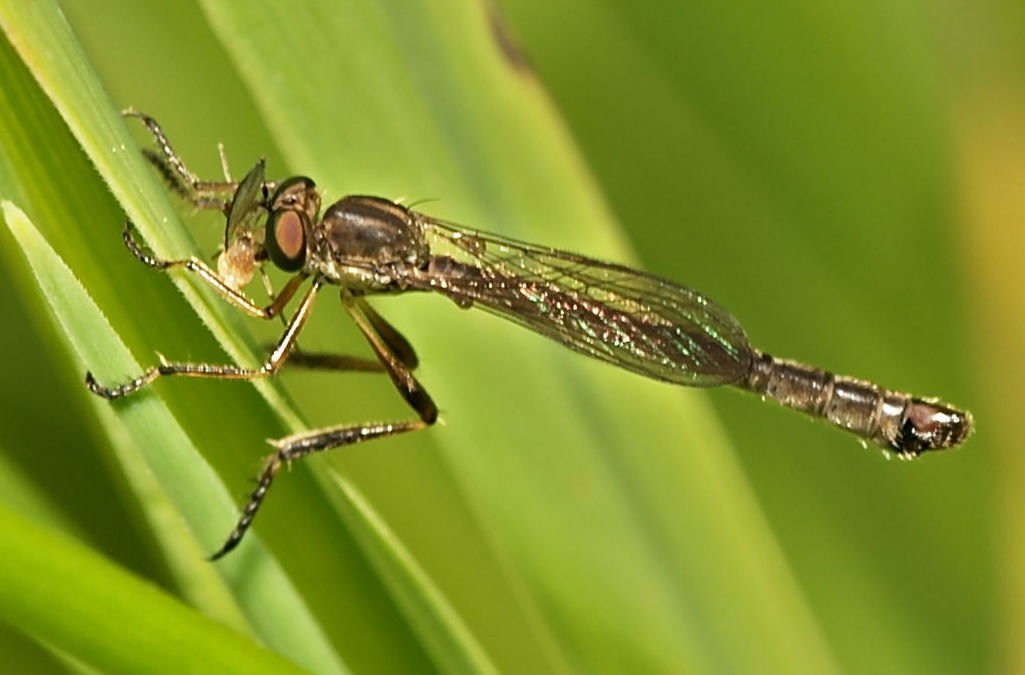- Home
- Garden Wildlife
- Insects
- True flies
- Soldier and robber flies
Soldier and robber flies
Soldier flies are in the families Xylomyidae and Stratiomyidae. The wood soldier flies in the Xylomiidae are unusual among dipterans in having larvae that consume dead and decaying wood. Jennifer Owen recorded Solva marginata, one of the three wood soldier fly species in Britain and Ireland.
Most soldier flies are in the Stratiomyidae, and vary a lot in shape and size, some being as long as 20mm. While some are aquatic as larvae, those found in gardens are terrestrial, feeding on decomposing material. Adults are somewhat flattened, often shiny metallic and colourful, and occasional nectar feeders. At rest, they usually place one wing over the other. Jennifer Owen found 12 species from 5 genera in her malaise trap samples, of which the commonest were Microchrysa polita and Beris chalybata. The latter species rejoices in the common name of "murky-legged black legionnaire" and is probably the most widespread in Britain and Ireland.

Murky-legged black legionnaire soldier fly Beris chalybata Soldier fly Sargus flavipes
Robber flies are in the family Asilidae, and are also called assassin flies. They are quite large and powerful flies that almost uniquely in the Diptera, are active predators as adults. With their long thin bodies, very large eyes and long grasping legs, they are like mini-dragonflies. They tend to sit in wait on a trunk or plant stem, then attacking while in flight, going for stinging wasps and bees, grasshoppers and dragonflies - and even each other. They have strong piercing mouthparts through which they suck up their prey's juices after injecting a toxic paralytic and protein dissolving saliva. Some can deliver a very painful stab to humans if stressed. The hindmost legs of the adults are very long and used to capture their insect prey.
The larvae live in soil rotting material or leaf litter. Some eat detritus, others are predators on soft bodies insects. There are 28 species ion Britain and Ireland, although some are rare and habitat specialists. Jennifer Owen found one species, Dioctria rufipes in her garden study. A small species, Leptogaster cylindrica is also known in gardens, where it flies through long grass looking for small insects.
![Soldier fly Microchrysa polita Photo: by James Lindsey at Ecology of Commanster [CC BY-SA 2.5 (https://creativecommons.org/licenses/by-sa/2.5)]](images/Microchrysa.polita.female.jpg)
.jpg)
_-_female.jpg)
Wood soldier fly Solva marginata Soldier fly Microchrysa polita
.jpg)

Robber fly Dioctria rufipes with prey Robber fly Leptogaster cylindrica eating an aphid
Role of soldier and robber flies in gardens.
These attractive and interesting flies cause no problems to the gardener and exert no great influence on other garden wildlife.
Other sources of information
Websites
Steven Falk's page on Xylomyidae
Steven Falk's page on Stratiomyidae
Steven Falk's pages on Asilidae
Website of the Soldierflies and Allies Recording Scheme
Book
Stubbs, A. and Drake, M. (2014) British soldierflies and their allies. British Entomological and Natural History Society
Page drafted and compiled by Steve Head

![Soldier fly Microchrysa polita Photo: by James Lindsey at Ecology of Commanster [CC BY-SA 2.5 (https://creativecommons.org/licenses/by-sa/2.5)]](images/Microchrysa.polita.female.jpg)
Soldier and robber flies
Soldier flies are in the families Xylomyidae and Stratiomyidae. The wood soldier flies in the Xylomiidae are unusual among dipterans in having larvae that consume dead and decaying wood. Jennifer Owen recorded Solva marginata, one of the three wood soldier fly species in Britain and Ireland.
Most soldier flies are in the Stratiomyidae, and vary a lot in shape and size, some being as long as 20mm. While some are aquatic as larvae, those found in gardens are terrestrial, feeding on decomposing material. Adults are somewhat flattened, often shiny metallic and colourful, and occasional nectar feeders. At rest, they usually place one wing over the other. Jennifer Owen found 12 species from 5 genera in her malaise trap samples, of which the commonest were Microchrysa polita and Beris chalybata. The latter species rejoices in the common name of "murky-legged black legionnaire" and is probably the most widespread in Britain and Ireland.
.jpg)
_-_female.jpg)
Murky-legged black legionnaire Beris chalybata Soldier fly Sargus flavipes
Robber flies are in the family Asilidae, and are also called assassin flies. They are quite large and powerful flies that almost uniquely in the Diptera, are active predators as adults. With their long thin bodies, very large eyes and long grasping legs, they are like mini-dragonflies. They tend to sit in wait on a trunk or plant stem, then attacking while in flight, going for stinging wasps and bees, grasshoppers and dragonflies - and even each other. They have strong piercing mouthparts through which they suck up their prey's juices after injecting a toxic paralytic and protein dissolving saliva. Some can deliver a very painful stab to humans if stressed. The hindmost legs of the adults are very long and used to capture their insect prey.
The larvae live in soil rotting material or leaf litter. Some eat detritus, others are predators on soft bodies insects. There are 28 species ion Britain and Ireland, although some are rare and habitat specialists. Jennifer Owen found one species, Dioctria rufipes in her garden study. A small species, Leptogaster cylindrica is also known in gardens, where it flies through long grass looking for small insects.
Wood soldier fly Solva marginata Soldier fly Microchrysa polita
Wood soldier fly Solva marginata Soldier fly Microchrysa polita
.jpg)

Robber fly Dioctria rufipes with prey Robber fly Leptogaster cylindrica eating an aphid
Role of soldier and robber flies in gardens.
These attractive and interesting flies cause no problems to the gardener and exert no great influence on other garden wildlife.
Other sources of information
Websites
Book
Stubbs, A. and Drake, M. (2014) British soldierflies and their allies. British Entomological and Natural History Society
Page drafted and compiled by Steve Head












